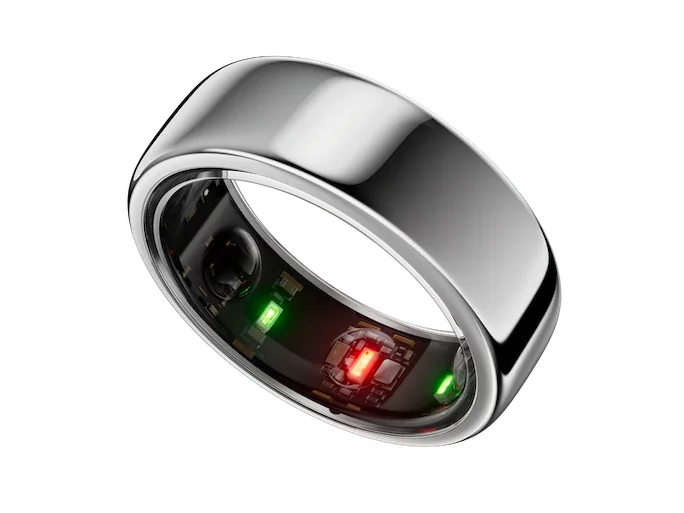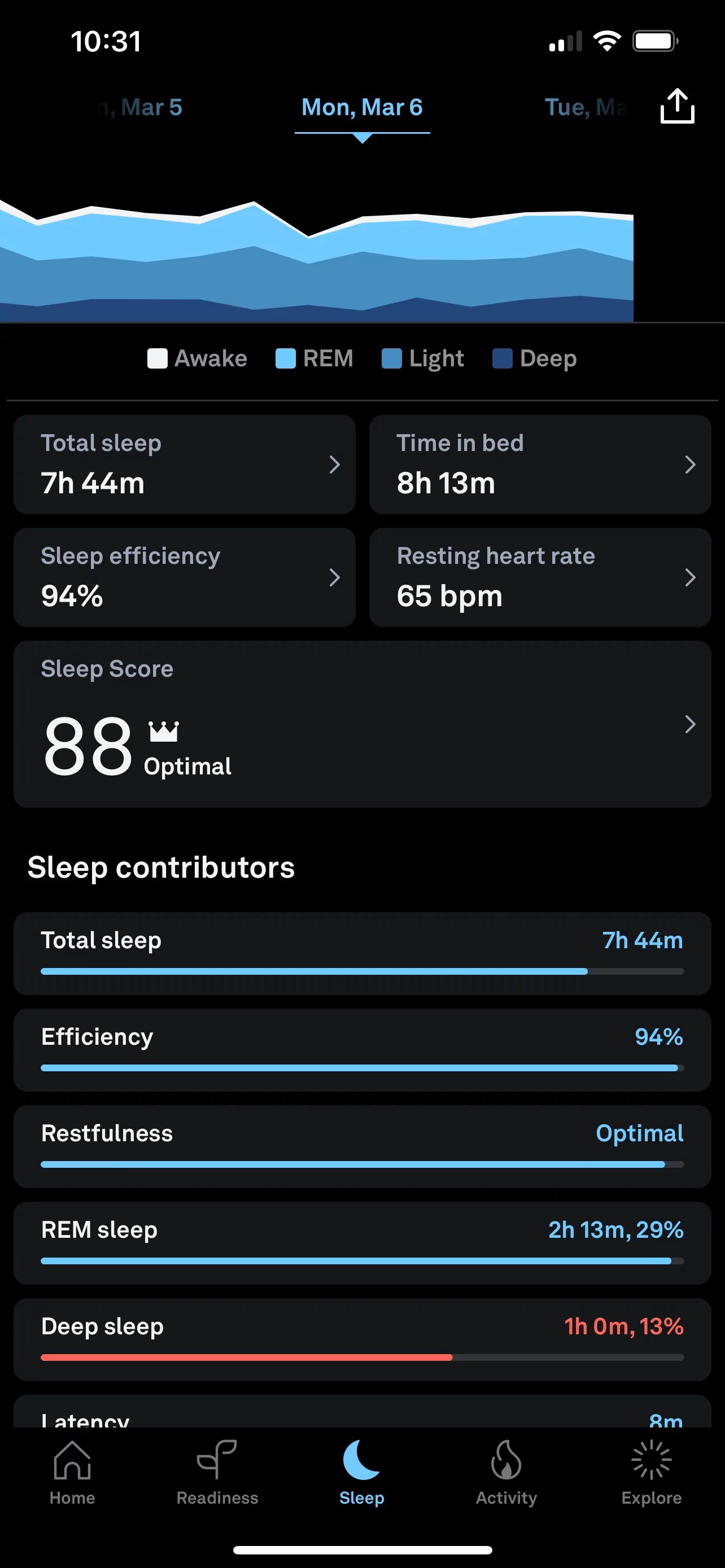I Actually Listened to My Wearable’s Advice on When To Go To Sleep, and I’m Shocked by How Much More Energetic I Am at the Gym


In a dream world, we'd actually listen to our phones and smart watches when they told us to go to bed already. But since we live in real life, on a planet with never-ending to-do lists, demanding jobs, children, and no Time Turner in sight, digital sleep recommendations often go ignored. This was the case for me, a human woman who very clearly needs at least seven hours of sleep to achieve baseline functionality but forgoes REM in lieu of late night emails and TikTok scrolling.
It's a problem. But it's one I've been working on solving for the past six months using a wearable I've owned about a year: The Oura Ring Gen 3 ($299). The Ring's sleep tracking capabilities have not only helped me optimize my snoozing habits, but they've helped increase my performance at the gym. (The Oura Ring actually does a whole lot more, but you can read our full Oura Ring review some other time.) If you're in the market for a sleep wearable to recalibrate your sleep schedule, here's everything you'll want to know about Oura Ring's sleep data capabilities—from myself as well the experts.

Available in five finishes including silver, gold, and rose gold.
Sleep analysis, which is included in Oura’s monthly membership, is $5.99/month.
How Oura Ring works and what it tracks
Before we get into its sleep data tech, here's a quick breakdown of the Oura Ring. The Ring (not to be confused with The Ring) is a health tracker you wear as—you guessed it—a ring, and it monitors your heart rate, body temperature, movement, blood oxygen levels, readiness (basically, your energy level), and your sleep. It uses photoplethysmography (PPG) technology to do all this. "Basically, the device uses light and light sensors to detect changes in blood flow. The device sends light into the skin and measures how much light is reflected back from the tissues," Sharon Gam, PhD, CSCS, a personal trainer and health coach, previously explained.

The sleep function is the most important trackers for me, since sleep efficiency is something that impacts my workday and my workout—if I don't get enough sleep, I feel sluggish, cranky, and am unable to retain an iota of focus. Plus, I have way less energy for the gym and find my endurance takes a major hit. A two-mile run I'd normally be able to do at a three- or four-level incline becomes unfeasible, I reach muscle fatigue much quicker when I'm lifting weights, and I find myself taking way more walking (and sitting) recoveries.

{{post.sponsorText}}
Oura's sleep monitoring capabilities
Sleep stages
When you sleep, Oura is tracking four sleep stages: Deep sleep (which is physically restorative), REM sleep (mentally restorative), light sleep, and awake. You want to get a good amount of deep and REM sleep to really get the most out of your slumber.
Sleep score
This ranges from 1-100, and the higher the score, the better (makes sense!). Your score is totally personalized and based on data like total sleep, REM, deep sleep, heart rate, heart rate variability (HRV), and a few other factors.
Bedtime guidance
Oura recommends how much sleep you should get by learning your individualized sleep patterns and learning from your best nights of sleep. Over time, it might even re-calculate what time you should go to bed for optimal performance the next day based on how well (or poorly) you've been sleeping or recovering.
For months, I noticed my more vigorous workouts weren't making me feel better—I felt worse. More tired. I didn't feel stronger. During a routine check-up, my GP asked if I was getting enough sleep. I said "yes," but then started wondering why, even after eight hours, I still felt so tired all the time (my bloodwork showed I was perfectly healthy otherwise, with no pre-existing conditions that would impact my energy levels).
That's when I decided to really listening to the Ring's sleep time suggestion, and its personalized bedtime for me is between 10:15 and 11:15 p.m. As I've learned over the past six months, just because you're clocking in eight hours of sleep, doesn't mean you're getting the highest quality rest. "Not all eight hour nights are created equal! Many of our members discover something they didn’t know was disturbing their sleep like a pet jumping on the bed at night, light coming in too early in the morning, or a late night meal preventing their heart rate from lowering into restorative sleep," Caroline Kryder, Oura's science communication lead explains.
In my case, even when I was getting eight hours, they'd be interrupted because I'd get up at 3 a.m. to pee, nudge my husband to stop snoring so loudly, or make room for one of my 85-pound dogs who felt like cuddling that night. Once I addressed these sleep disruptors (still working on the snoring husband problem—if anyone has any tips, shoot me an email), I upped the amount of deep sleep and REM. As a shock to absolutely no one, I felt far more well-rested.
How Oura Ring's sleep tracking helps increase workout performance
When you get better sleep, you have more energy. It's not rocket science, but I really thought I'd out-caffeinate my sleep deprivation and be fine at the gym—I was definitely wrong.
"While workouts boost endurance and strength, rest and recovery during sleep allows our bodies to adapt in response to those workouts," Kyrder says. "That’s because during exercise, you’re challenging your body with strain (on your heart, your muscles, etc.). If you don’t give your body enough time to recover from that strain, the next workout is only adding to the toll on your body, rather than helping you get back to baseline or grow stronger."
Sleep allows your body to reset and recalibrate, making it stronger and more functional for the following day. "During sleep, the body produces hormones that help repair muscles, cells, and regulate energy use," explains Jayne Morgan, MD, cardiologist, executive director of health and community education at Piedmont Healthcare, and creator of the blog, Stairwell Chronicles. This only happens when you get restorative sleep, which is the ultimate goal. "In order to get restorative sleep, the body must enter the deep sleep stage known as non-REM sleep. It is this stage of sleep when the pituitary gland releases growth hormones that stimulate both muscle repair and growth."
When you rack up deep sleep, you're increasing blood flow throughout your body. "Additionally, in the deeper stages of sleep, there is increased blood flow and oxygen delivery to the muscles. This also supports the regenerative and recovery state of muscles and cells," explains Dr. Morgan.
Lastly, sleep fights inflammation with an increase of prolactin. "Prolactin is a hormone that helps regulate inflammation, is also released while sleeping. So, not enough rest and sleep? Increased inflammation of the body and muscles, working against muscle recovery restoration and regeneration. And so the converse is that lack of sleep puts one at risk of further injury," says Dr. Morgan.
My experience
For the last half-year, I've been pretty diligent about following my Ring's personalized bedtime (except for weekends, since I can sleep in and generally use them as rest or recovery days, anyway). I'll go to bed no later than 11 p.m. on weekdays, and have noticed that the earlier I go to bed, the better I feel the next day. No brainer, though, right? What really surprised me was how much better my performance has been at the gym. I felt like I could take on more: more mileage and incline on the treadmill, as well as heavier weights in the weight room.
Thanks to the amount (and quality) of sleep I've been getting, I feel (and see!) actual muscle growth, and that's not something I've experienced before when I relied on coffee and energy drinks before the gym to fuel my body. My energy at the gym (I take two Orangetheory Fitness classes—which are HIIT-based workouts—a week, and then jog and lift weights two-to-three times a week at my local gym) is more sustainable, too—I don't gas out after 20 minutes like I used to. I can jog for 30 minutes and then still be able to row or lift with fuel still left in the tank.
Here are some examples of my Oura Ring sleep data:
For this particular night of sleep, I earned a 94 percent "efficiency" grade on my sleep. While I actually "slept-slept" for seven hours (you'll see in a second), the Ring tracked how optimized my rest was.

A more in-depth look into my quality of sleep shows I got decent REM sleep, but could have snoozed more deeply. Still—I clearly got enough deep sleep to help my performance at the gym the next day.

And here's my Activity Score that Monday: That day, I crushed it at my Orangetheory class, and on top of that, I walked my dogs for 45 minutes—all of that contributing to 12,000+ steps walked and nearly 800 calories burned. That's thanks to how well I recovered during the night (plus staying on top of my nutrition and stress levels!).

On nights my sleep quality indicate I need more recovery time, Oura sends me a report the next morning suggesting I take it down on a notch on movement (either gentle movement or a rest day). These are the days I skip the gym, or go on a short walk with the dogs to give my body a break (read more on why it's extra important to give yourself rest days).

The following day after a break, I'm even more pumped and energetic at the gym—I'm far more efficient. It's like I was a phone on 5 percent battery that spent the night recharging (I'm no doctor, but that's basically...what good sleep is, right? A good phone charger?). It's the reset I clearly need—and it's really cool being able to use Oura Ring as a way to send me reminders I need this in my fitness journey.
"When used correctly and with good engagement and motivation, fitness trackers are tools that can help both motivate and encourage movement, sleep, calorie consumption, energy use, and other health related activities. In many ways, they serve as the coach and/or accountability partner," reminds Dr. Morgan.
The Oura Ring has been the accountability partner my fitness routine has needed for a long time—and the payoff shows.
Loading More Posts...
